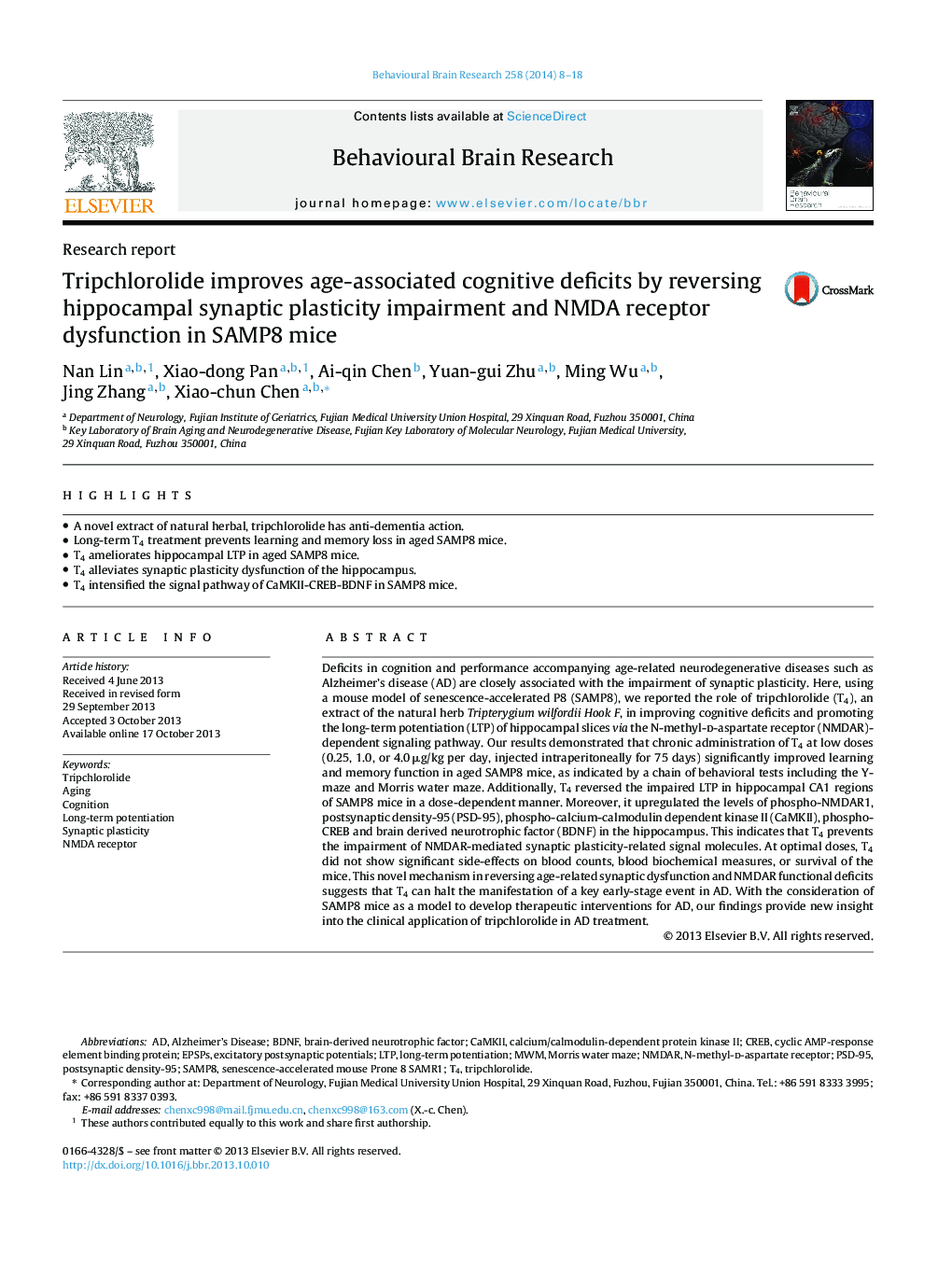| کد مقاله | کد نشریه | سال انتشار | مقاله انگلیسی | نسخه تمام متن |
|---|---|---|---|---|
| 6258424 | 1612974 | 2014 | 11 صفحه PDF | دانلود رایگان |
عنوان انگلیسی مقاله ISI
Tripchlorolide improves age-associated cognitive deficits by reversing hippocampal synaptic plasticity impairment and NMDA receptor dysfunction in SAMP8 mice
دانلود مقاله + سفارش ترجمه
دانلود مقاله ISI انگلیسی
رایگان برای ایرانیان
کلمات کلیدی
CREBcyclic AMP-response element binding proteinEPSPsCaMKIIMWMNMDARPSD-95SAMP8BDNF - BDNF یا فاکتور نورونزایی مشتقشده از مغز Alzheimer's disease - بیماری آلزایمرpostsynaptic density-95 - تراکم پست سیناپتیک 95long-term potentiation - تقویت درازمدتLTP - تقویت طولانی مدت یا LTP Brain-derived neurotrophic factor - فاکتور نوروتروفی مشتق شده از مغزMorris water maze - ماز آب آب موریسexcitatory postsynaptic potentials - پتانسیل های پست پراکنده تحریک پذیرcalcium/calmodulin-dependent protein kinase II - پروتئین کیناز II وابسته به کلسیم / کالودولینN-methyl-d-aspartate receptor - گیرنده N-methyl-d-aspartate
موضوعات مرتبط
علوم زیستی و بیوفناوری
علم عصب شناسی
علوم اعصاب رفتاری
پیش نمایش صفحه اول مقاله

چکیده انگلیسی
Deficits in cognition and performance accompanying age-related neurodegenerative diseases such as Alzheimer's disease (AD) are closely associated with the impairment of synaptic plasticity. Here, using a mouse model of senescence-accelerated P8 (SAMP8), we reported the role of tripchlorolide (T4), an extract of the natural herb Tripterygium wilfordii Hook F, in improving cognitive deficits and promoting the long-term potentiation (LTP) of hippocampal slices via the N-methyl-d-aspartate receptor (NMDAR)-dependent signaling pathway. Our results demonstrated that chronic administration of T4 at low doses (0.25, 1.0, or 4.0 μg/kg per day, injected intraperitoneally for 75 days) significantly improved learning and memory function in aged SAMP8 mice, as indicated by a chain of behavioral tests including the Y-maze and Morris water maze. Additionally, T4 reversed the impaired LTP in hippocampal CA1 regions of SAMP8 mice in a dose-dependent manner. Moreover, it upregulated the levels of phospho-NMDAR1, postsynaptic density-95 (PSD-95), phospho-calcium-calmodulin dependent kinase II (CaMKII), phospho-CREB and brain derived neurotrophic factor (BDNF) in the hippocampus. This indicates that T4 prevents the impairment of NMDAR-mediated synaptic plasticity-related signal molecules. At optimal doses, T4 did not show significant side-effects on blood counts, blood biochemical measures, or survival of the mice. This novel mechanism in reversing age-related synaptic dysfunction and NMDAR functional deficits suggests that T4 can halt the manifestation of a key early-stage event in AD. With the consideration of SAMP8 mice as a model to develop therapeutic interventions for AD, our findings provide new insight into the clinical application of tripchlorolide in AD treatment.
ناشر
Database: Elsevier - ScienceDirect (ساینس دایرکت)
Journal: Behavioural Brain Research - Volume 258, 1 January 2014, Pages 8-18
Journal: Behavioural Brain Research - Volume 258, 1 January 2014, Pages 8-18
نویسندگان
Nan Lin, Xiao-dong Pan, Ai-qin Chen, Yuan-gui Zhu, Ming Wu, Jing Zhang, Xiao-chun Chen,